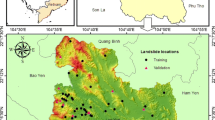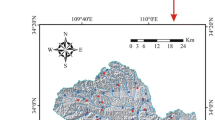Abstract
Due to the particular geographical location and complex geological conditions, the Three Gorges of China suffer from many landslide hazards that often result in tragic loss of life and economic devastation. To reduce the casualty and damages, an effective and accurate method of assessing landslide susceptibility is necessary. Object-based data mining methods were applied to a case study of landslide susceptibility assessment on the Guojiaba Town of the Three Gorges. The study area was partitioned into object mapping units derived from 30 m resolution Landsat TM images using multi-resolution segmentation algorithm based on the landslide factors of engineering rock group, homogeneity, and reservoir water level. Landslide locations were determined by interpretation of Landsat TM images and extensive field surveys. Eleven primary landslide-related factors were extracted from the topographic and geologic maps, and satellite images. Those factors were selected as independent variables using significance testing and correlation coefficient analysis, including slope, profile curvature, engineering rock group, slope structure, distance from faults, land cover, tasseled cap transformation wetness index, reservoir water level, homogeneity, and first and second principal components of the images. Decision tree and support vector machine (SVM) models with the optimal parameters were trained and then used to map landslide susceptibility, respectively. The analytical results were validated by comparing them with known landslides using the success rate and prediction rate curves and classification accuracy. The object-based SVM model has the highest correct rate of 89.36 % and a kappa coefficient of 0.8286 and outperforms the pixel-based SVM, object-based C5.0, and pixel-based SVM models.












Similar content being viewed by others
References
Akgun A, Sezer EA, Nefeslioglu HA, Gokceoglu C, Pradhan B (2012) An easy-to-use MATLAB program (MamLand) for the assessment of landslide susceptibility using a Mamdani fuzzy algorithm. Comput Geosci 38(1):23–34
Aleotti P, Chowdhury R (1999) Landslide hazard assessment: summary review and new perspectives. B Eng Geol Environ 58(1):21–44
Althuwaynee OF, Pradhan B, Lee S (2012) Application of an evidential belief function model in landslide susceptibility mapping. Comput Geosci 44:120–135
Ballabio C, Sterlacchini S (2012) Support vector machines for landslide susceptibility mapping: the Staffora river basin case study, Italy. Math Geosci 44:47–70
Basheer IA, Hajmeer M (2000) Artificial neural networks: fundamentals, computing, design, and application. J Microbiol Meth 43:3–31
Bui DT, Pradhan B, Lofman O, Revhaug I (2012a) Landslide susceptibility assessment in Vietnam using support vector machines, decision tree and Naïve Bayes models. Math Probl Eng. doi:10.1155/2012/974638
Bui DT, Pradhan B, Lofman O, Revhaug I, Dick OB (2012b) Landslide susceptibility assessment in the Hoa Binh province of Vietnam: a comparison of the Levenberg-Marquardt and Bayesian regularized neural networks. Geomorphology 171–172:12–29
Bui DT, Pradhan B, Lofman O, Revhaug I, Dick OB (2012c) Spatial prediction of landslide hazards in Hoa Binh province (Vietnam): a comparative assessment of the efficacy of evidential belief functions and fuzzy logic models. Catena 96:28–40
Carro M, De Amicis M, Luzi L, Marzorati S (2003) The application of predictive modeling techniques to landslides induced by earthquakes, the case study of the 26 September 1997 Umbria–Marche earthquake (Italy). Eng Geol 69:139–159
Cho JH, Kurup PU (2011) Decision tree approach for classification and dimensionality reduction of electronic nose data. Sensor Actuat B 160(1):542–548
Choi J, Oh HJ, Won JS, Lee S (2010) Validation of an artificial neural network model for landslide susceptibility mapping. Environ Earth Sci 60:473–483
Chung CF, Fabbri AG (2003) Validation of spatial prediction models for landslide hazard mapping. Nat Hazards 30:451–472
Crist EP, Laurin R, Cicone RC (1986) Vegetation and soils information contained in transformed thematic mapper data. In: Proceedings of IGARSS symposium, Zurich, 1986
Definiens 2007 Developer 8: userguide. Definiens Imaging GmbH
Deng QL, Zhu ZY, Cui ZQ, Wang XP (2000) Mass rock creep and landsliding on the Huangtupo slope in the reservoir area of the Three Gorges project, Yangtze River, China. Eng Geol 58:67–83
Erener A, Duzgun HSB (2012) Landslide susceptibility assessment: what are the effects of mapping unit and mapping method? Environ Earth Sci 66:859–877
Falaschi F, Giacomelli F, Federici PR, D’Amato Avanzi G, Pochini A, Ribolini A (2009) Logistic regression versus artificial neural networks: landslide susceptibility evaluation in a sample area of the Serchio River valley, Italy. Nat Hazards 50:551–569
Fourniadis IG, Liu JG, Mason P (2007) Landslide hazard assessment in the Three Gorges area, China, using ASTER imagery: Wushan–Badong. Geomorphology 84:126–144
Gokceoglu C, Sonmez H, Ercanoglu M (2000) Discontinuity controlled probabilistic slope failure risk maps of the Altindag (settlement) region in Turkey. Eng Geol 55:277–296
Gorsevski PV, Jankowski P (2008) Discerning landslide susceptibility using rough sets. Comput Environ Urban 32:53–65
Guzzetti F, Reichenbach P, Ardizzone F, Cardinali M, Galli M (2006) Estimating the quality of landslide susceptibility models. Geomorphology 81(1–2):166–184
He SW, Pan P, Dai L, Wang HJ, Liu JP (2012) Application of kernel-based Fisher discriminant analysis to map landslide susceptibility in the Qinggan River delta, Three Gorges, China. Geomorphology 171–172:30–41
Hubei Province Geological Survey (1965) Geological map of Zigui-Wushan (1:200,000)
Liu JG, Mason PJ, Clerici N, Chen S, Davis A, Miao F, Deng H, Liang L (2004) Landslide hazard assessment in the Three Gorges area of theYangtze river using ASTER imagery: Zigui–Badong. Geomorphology 61:171–187
Liu JP, Zeng ZP, Liu HQ, Wang HB (2011) A rough set approach to analyze factors affecting landslide incidence. Comput Geosci 37:1311–1317
Marjanovic M, Kovacevic M, Bajat B, Vozenılek V (2011) Landslide susceptibility assessment using SVM machine learning algorithm. Eng Geol 123(3):225–234
Miller HJ, Han J (2001) Geographic data mining and knowledge discovery: An overview. In: Miller HJ, Han J (eds) Geographic data mining and knowledge discovery. Taylor and Francis, London, pp 3–32
Murthy SK (1998) Automatic construction of decision trees from data: a multi-disciplinary survey. Data Min Knowl Disc 2(4):345–389
Myles AJ, Feudale RN, Liu Y, Woody NA, Brown SD (2004) An introduction to decision tree modeling. J Chemometr 18(6):275–285
Nandi A, Shakoor A (2008) Application of logistic regression model for slope instability prediction in Cuyahoga River Watershed, Ohio. USA. Georisk 2(1):16–27
Nefeslioglu HA, Gokceoglu C, Sonmez H (2008) An assessment on the use of logistic regression and artificial neural networks with different sampling strategies for the preparation of landslide susceptibility maps. Eng Geol 97:171–191
Pourghasemi HR, Pradhan B, Gokceoglu C (2012) Application of fuzzy logic and analytical hierarchy process (AHP) to landslide susceptibility mapping at Haraz watershed Iran. Nat Hazards 63(2):965–996
Pradhan B (2010a) Application of an advanced fuzzy logic model for landslide susceptibility analysis. Int J Comput Int Sys 3(3):370–381
Pradhan B (2010b) Landslide susceptibility mapping of a catchment area using frequency ratio, fuzzy logic and multivariate logistic regression approaches. J Indian Soc Remote Sens 38(2):301–320
Pradhan B (2010c) Remote sensing and GIS-based landslide hazard analysis and cross-validation using multivariate logistic regression model on three test areas in Malaysia. Adv Space Res 45(10):1244–1256
Pradhan B (2011a) Manifestation of an advanced fuzzy logic model coupled with geoinformation techniques to landslide susceptibility mapping and their comparison with logistic regression modelling. Environ Ecol Stat 18(3):471–493
Pradhan B (2011b) Use of GIS-based fuzzy logic relations and its cross application to produce landslide susceptibility maps in three test areas in Malaysia. Environ Earth Sci 63(2):329–349
Pradhan B (2013) A comparative study on the predictive ability of the decision tree, support vector machine and neuro-fuzzy models in landslide susceptibility mapping using GIS. Comput Geosci 51:350–365
Pradhan B, Buchroithner MF (2010) Comparison and validation of landslide susceptibility maps using an artificial neural network model for three test areas in Malaysia. Environ Eng Geosci 16(2):107–126
Pradhan B, Lee S (2010a) Landslide susceptibility assessment and factor effect analysis: back propagation artificial neural networks and their comparison with frequency ratio and bivariate logistic regression modeling. Environ Modell Softw 25:747–759
Pradhan B, Lee S (2010b) Regional landslide susceptibility analysis using back-propagation neural network model at Cameron Highland, Malaysia. Landslides 7:12–30
Pradhan B, Pirasteh P (2010) Comparison between prediction capabilities of neural network and fuzzy logic techniques for landslide susceptibility mapping. Disa Adv 3(2):26–34
Pradhan B, Youssef AM, Varathrajoo R (2010a) Approaches for delineating landslide hazard areas using different training sites in an advanced artificial neural network model. Geo-Spatial Inf Sci 13(2):93–102
Pradhan B, Oh HJ, Buchroithner M (2010b) Weights-of-evidence model applied to landslide susceptibility mapping in a tropical hilly area. Geomat Nat Hazards Risk 1(3):199–223
Pradhan B, Mansor S, Pirasteh S, Buchroithner MF (2011) Landslide hazard and risk analyses at a landslide prone catchment area using statistical based geospatial model. Int J Remote Sens 32(14):4075–4087
Richards JA (1999) Remote sensing digital image analysis: an introduction. Springer-Verlag, Berlin
Rotigliano E, Cappadonia C, Conoscenti C, Costanzo D, Agnesi V (2012) Slope units-based flow susceptibility model: using validation tests to select controlling factors. Nat Hazards 61:143–153
Scholkopf B, Smola A, Williamson RC, Bartlett PL (2000) New support vector algorithms. Neural Comput 12:1207–1245
Sorensen K, Janssens GK (2003) Data mining with genetic algorithms on binary trees. Eur J Oper Res 151:253–264
Stumpf A, Kerle N (2011) Object-oriented mapping of landslides using random forests. Remote Sens Environ 115:2564–2577
Vapnik V (1995) Nature of statistical learning theory. Wiley, New York
Wang XM, Niu RQ (2010) Landslide intelligent prediction using object-oriented method. Soil Dyn Earthq Eng 30:1478–1486
Wu SR, Shi L, Wang RJ, Tan CX, Hu DG, Mei YT, Xu RC (2001) Zonation of the landslide hazards in the forereservoir region of the Three Gorges project on the Yangtze River. Eng Geol 59:51–58
Yao X, Tham LG, Dai FC (2008) Landslide susceptibility mapping based on support vector machine: a case study on natural slopes of Hong Kong, China. Geomorphology 101:572–582
Yeon YK, Han JG, Ryu KH (2010) Landslide susceptibility mapping in Injae, Korea, using a decision tree. Eng Geol 116(3–4):274–283
Zarea M, Pourghasemi HR, Vafakhah M, Pradhan B (2012) Landslide susceptibility mapping at Vaz watershed (Iran) using an artificial neural network model: a comparison between multi-layer perceptron (MLP) and radial basic function (RBF) algorithms. Arab J Geosci. doi:10.1007/s12517-012-0610-x
Acknowledgments
Thanks to Dr. LaMoreaux and three anonymous reviewers for their valuable comments. This study is jointly supported by NSFC (41271455/D0108), Fundamental Research Funds for the Central Universities, China University of Geosciences (Wuhan) (CUGL120207).
Author information
Authors and Affiliations
Corresponding author
Rights and permissions
About this article
Cite this article
Wu, X., Ren, F. & Niu, R. Landslide susceptibility assessment using object mapping units, decision tree, and support vector machine models in the Three Gorges of China. Environ Earth Sci 71, 4725–4738 (2014). https://doi.org/10.1007/s12665-013-2863-4
Received:
Accepted:
Published:
Issue Date:
DOI: https://doi.org/10.1007/s12665-013-2863-4




